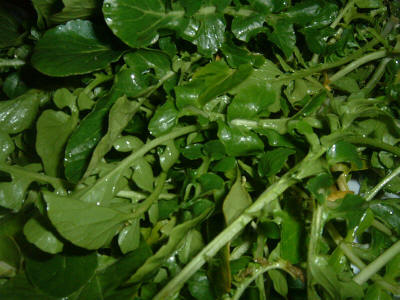|

by Paul Fassa
September 11, 2011
from
NaturalNews Website
If watercress is served as a garnishment
in a restaurant, don't throw it out. Eat it with the food served. It
will help you digest your meal and provide many more health benefits
than most know about.
As a matter of fact, you'd be wise to
mix it in salads or juice it with other veggies often.
Watercress
Details
Watercress is a leafy green
cruciferous that's been around for a long time. It gets its name
from the fact that it originally grew wild along the banks of
streams and slow moving rivers.

Essentially it is a water plant. They
have long green stems with small roundish bright green leaves.
The early Romans and ancient Persians used watercress as,
-
a brain food
-
a nerve tonic
-
an aphrodisiac
Perhaps they overdid the latter.
It is
often used as a throw-away garnish. But its nutrient value is so
high its bitter peppery tasting leaves deserve to be eaten uncooked
often.
Naturally, raw leaves offer the highest nutrient value. But
watercress can be juiced with other vegetables or even used for
soups. For soups, place watercress in the water after reaching a
boiling point to avoid destroying the nutrients by overheating.
Once you find a good source of organic watercress, you can
wrap the leaves around grapes or pineapple chunks and snack with
them. You can mix raw watercress leaves with other greens for
salads. Many consider watercress too bitter to eat alone.
Try it that way first then decide.
Health
Benefits
Watercress is considered an anti-aging food, as good as or even
better than many herbs used for that purpose.
It contains a lot of
lutein, which helps improve or
maintain eye health despite aging. Watercress is very high in
naturally occurring iodine. So high that it is not advised for
anyone with
hyperthyroidism.
However, hyperthyroidism is rare these days. Hypothyroidism is much
more prevalent because iodine nutrients are not common in most
modern mineral deficient diets. Hypothyroidism causes lethargy,
depression, goiter, and poor metabolism leading to obesity. So
unless you're specifically diagnosed with hyperthyroidism, eat as
much watercress as you can.
The high iodine content gives watercress a nutritional breakaway
value from other cruciferous vegetables. Cruciferous veggies all
have cancer preventative nutrients. They are all high in
phytonutrient compounds containing different sulfur molecules. Some
of those sulfur nutrients assist the liver in its phase two
detoxification process.
Cruciferous vegetables also contain
enzymes that help the liver manufacture and transfer glutathione to
our bodies' cells. Glutathione is considered the master antioxidant
because it replenishes and recycles spent antioxidants for more
activity to protect cells from oxidative damage.
Don't confuse oxidation or oxidative damage with oxygenation,
without which cancer takes over healthy cells.
Oxygenation is part of a healthy
cell's function to properly metabolize cellular activity and growth
while creating energy.
So with sufficient antioxidants preventing cellular damage, whatever
enhances oxygenation is welcome. Watercress provides both
antioxidant activity and oxygenation. Its high chlorophyll content
provides what's essential for oxygenation and red blood cells.
Rotating watercress with other organic cruciferous uncooked or
lightly steamed veggies ensures your daily intake of many anti-aging
cancer inhibiting nutrients.
Watercress is very low in calories too.
You can use it in a cheese sandwich for
balancing out all those other calories.
Nutrient Content
http://healthbenefitsofwatercress.com/
|
Vitamins:
Minerals:
-
Manganese
-
Calcium
-
Iron
-
Potassium
-
Copper
-
Iodine
|
Other:
Disease Prevention
-
Fights cancer with
potent anticancer compounds
-
Promotes vision
and overall eye health with carotenoids lutein and
zeaxanthin
-
Stabilizes
cholesterol and blood pressure
-
Improves
cardiovascular health
-
Decreases
incidence of breast cancer in women
|
Sources
|
